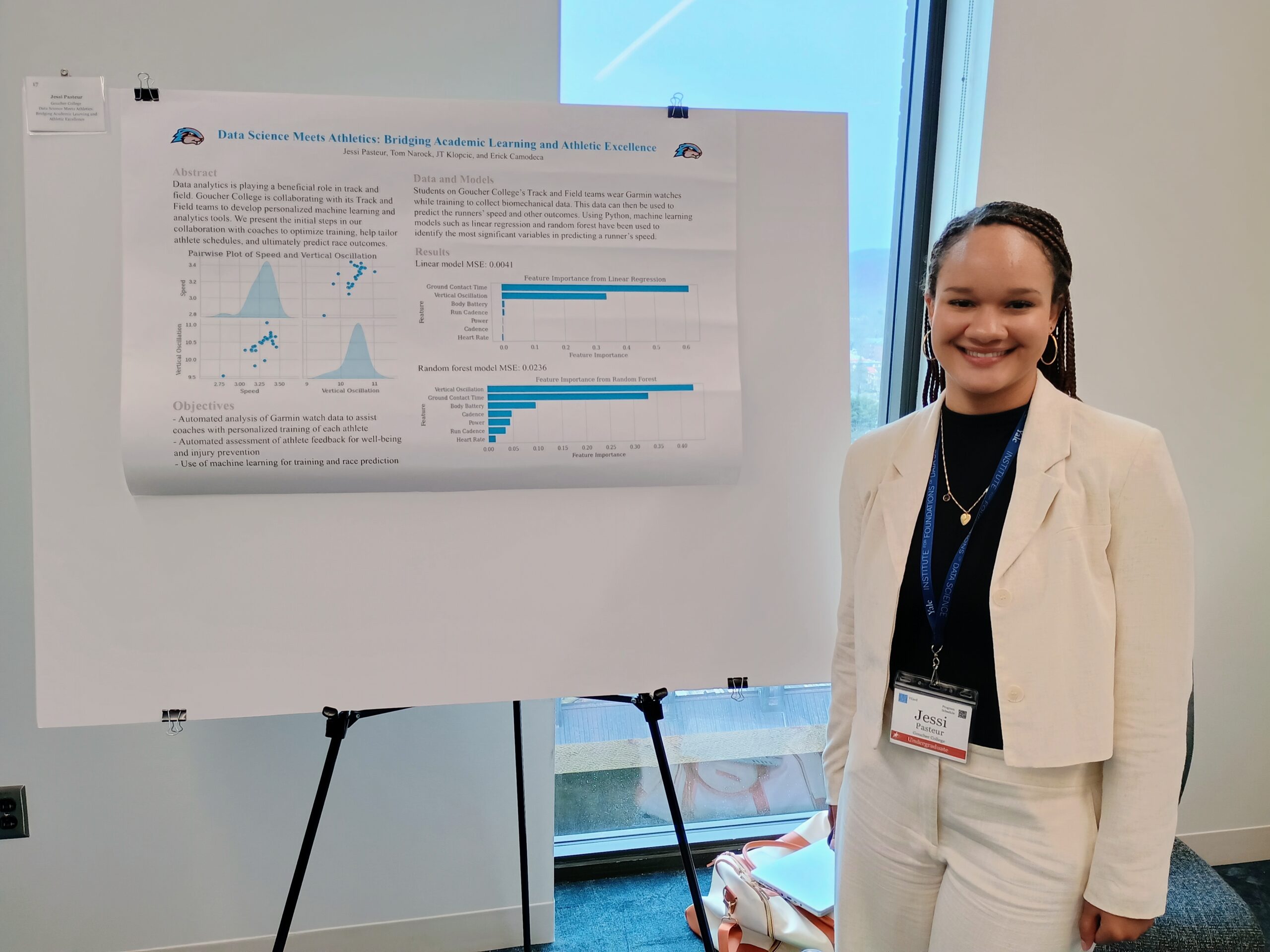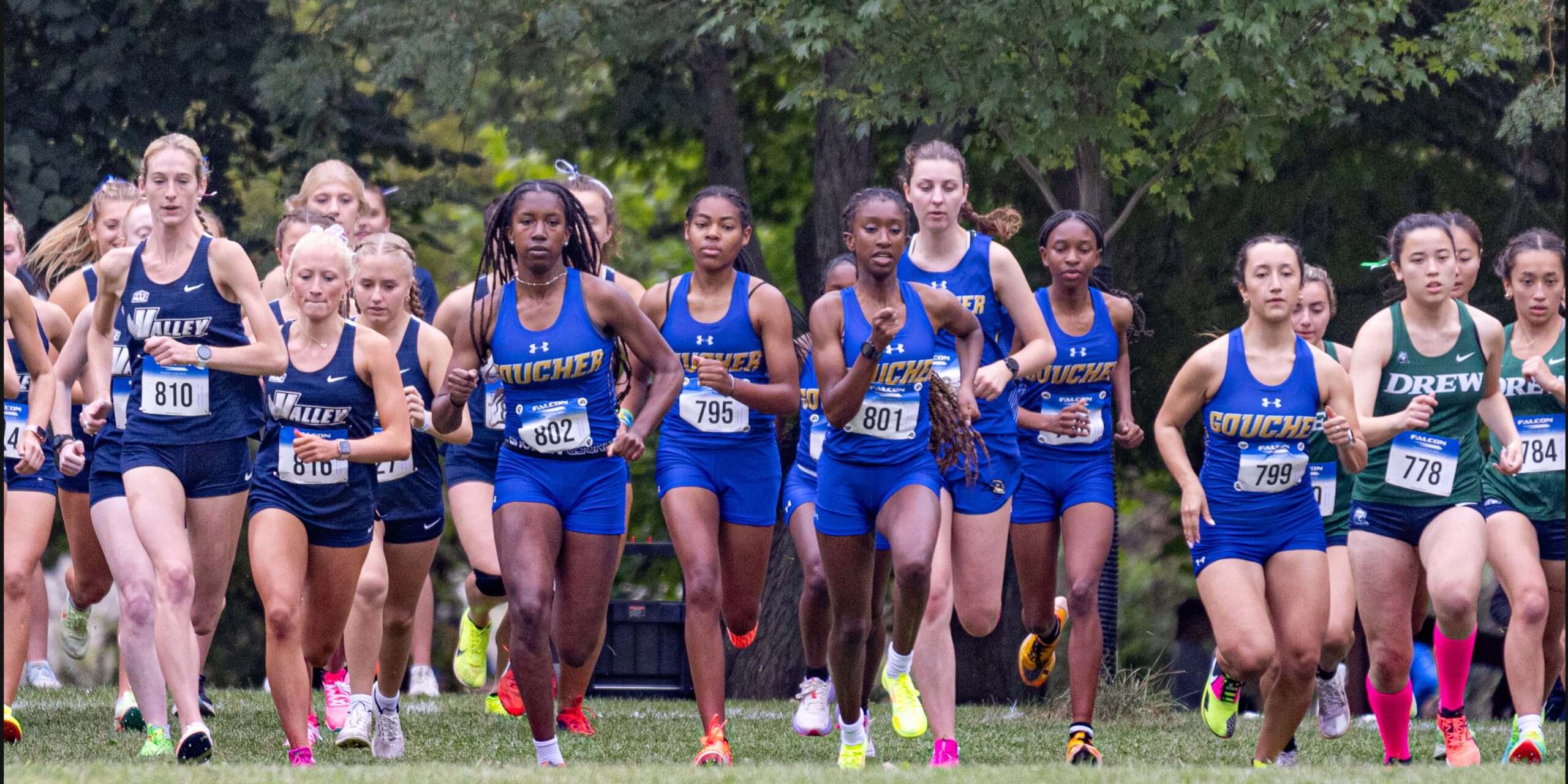Associate Professor of Data Analytics Tom Narock and the Goucher College cross country and track & field teams are working together on a co-curricular project examining how data science can impact athletic performance.
Narock was excited to explore new intellectual experiences outside of his traditional research area. This collaboration allows him to apply data science in a new domain while investigating options for enhancing Goucher’s data science curriculum to include a specialized track or concentration in sports analytics. As a Goucher sports fan, he says it’s also a fun way to engage with student athletes outside of the classroom.

The Evolution of Athletic Performance
The intersection of technology and athletics is transforming how teams train, compete, and excel. Sports analytics has emerged as a powerful tool that empowers coaches and athletes to achieve competitive advantages through strategic, data-driven decision-making. By systematically collecting, processing, and interpreting athletic data, coaches and athletes can make more informed decisions that impact performance both on and off the field.
At Goucher College, an innovative partnership is taking shape between the Athletics Department and data science faculty and students. This collaborative project focuses on Goucher’s cross country and track and field teams, incorporating advanced analytics into training insights with dual goals: improving training effectiveness and automating time-consuming processes. The collaboration represents a truly reciprocal relationship—Athletics gains access to cutting-edge analytical tools, while computer and data science students receive invaluable hands-on experience with real-world applications.
When Cross Country and Track & Field Head Coach Erick Camodeca ’06 took the helm of the program in 2020, he and his staff consistently looked for ways to push the program forward competitively. This new collaboration with the data science faculty has enabled the two programs to gain a competitive edge through a low-cost, high-return solution that adds both physiological and biomechanical training insights to the coaching staff’s toolkit, helping Goucher’s student athletes compete at the highest level.
The Complexity of Track and Field
The nature of track and field at the NCAA level makes it one of the more objectively measurable sports. Athletes run, jump, and throw, resulting in times, heights, and distances that can immediately rank them within a competition and on a larger scale as a team. However, achieving such marks requires nuance and art to combine with multiple forms of science, including physics, biology, chemistry, and psychology, to name a few.
Track & field encompasses 21 events—four jumping events, four throwing events, three hurdle events, eight running events, and two combined events—each containing a unique set of demands for athletes to achieve successful performance. Each event requires specific skills that athletes need to develop and train. A 100-meter runner will have a very different skill set from a hammer thrower but will also differ significantly from a 400-meter runner.
The Coach’s Challenge
The role of the coach is to craft training that helps the athlete better meet the unique demands of their events. Utilizing data analysis makes this process objective and provides insights for both the coach and the athlete. Coaches and athletes must regularly ask themselves several questions:
- What are the demands or components of the event?
- What qualities and components does an athlete need to compete successfully in the event?
- How can these components be measured over time to track development?
- What is the overall profile (biomechanical and physiological) the athlete currently possesses?
- How can the athlete’s profile be developed to meet the demands of the event for maximum performance?
Three Key Technological Innovations
The Goucher project encompasses three key technological innovations that help address these coaching challenges.
Automated Biomechanical Data Collection
Researchers are developing software to retrieve biomechanical data from Garmin watches, capturing metrics like cadence, heart rate, and stride length. This automated data collection generates personalized summaries that reveal how an athlete’s biomechanics evolve throughout training runs, reducing coaching workload and providing immediate insights into performance patterns and potential areas for improvement.
Data-Driven Athlete Classification
The team is implementing a classification system that categorizes runners into distinct physiological profiles. This approach recognizes that athletes respond differently to various workout types, allowing coaches to assess workout quality on an individual basis rather than applying one-size-fits-all training methods. By understanding each athlete’s unique profile, coaches can tailor training regimens to maximize effectiveness while minimizing injury risk.
Historical Performance Analysis
The third component involves historical data mining of the Track & Field Results Reporting System (TFRRS), analyzing athletes’ performance trajectories over time. This analysis identifies athletes who consistently excel in specific events and allows for regional and national comparisons with fellow NCAA athletes, enabling strategic decisions about event participation that maximize team scoring potential.
A Holistic Approach to Athletic Excellence
This comprehensive approach combines quantitative data with qualitative coaching insights, creating a holistic view of athletic performance. The project strengthens the bridge between academic learning and athletic excellence, demonstrating how data science can enhance traditional training methods.
The collaboration has received generous support from the Myra Berman Kurtz Fund for Faculty Research and Exploration of the Sciences (KRES Fund), enabling data science major Jessica Pasteur ’25 to travel to Yale University for the Connecticut Sports Analytics Symposium, where she highlighted initial results from the project.

Measurable Success
The results of this methodology and collaboration speak for themselves. The Goucher track and field teams are coming off the most successful seasons in program history, with the women’s team finishing 17th in the nation at NCAA nationals. Two Gopher athletes finished in the top three in their respective events, and both Erick Camodeca and JT Klopcic earned Head and Assistant Coach of the Year recognitions, respectively, from the U.S. Track and Field and Cross Country Coaches Association.
The program now has multiple first-year students entering regional and national-level competitions while achieving drastic improvements from their high school and prior institution personal bests. Goucher currently has the highest improvement rate in personal best marks among all Landmark Conference track & field teams, as well as the highest improvement rate in the Mid-Atlantic region. This is a testament to utilizing data-informed insights and statistical analysis to make individualized training decisions.
Looking Forward
As sports continue to evolve in the digital age, initiatives like this one showcase the immense potential of analytics to unlock human athletic potential while preparing the next generation of data-savvy professionals. Goucher College is positioning itself as an active participant in the sports analytics revolution, where the technology and athletics intersect to create unprecedented opportunities for athletic achievement and student learning.

